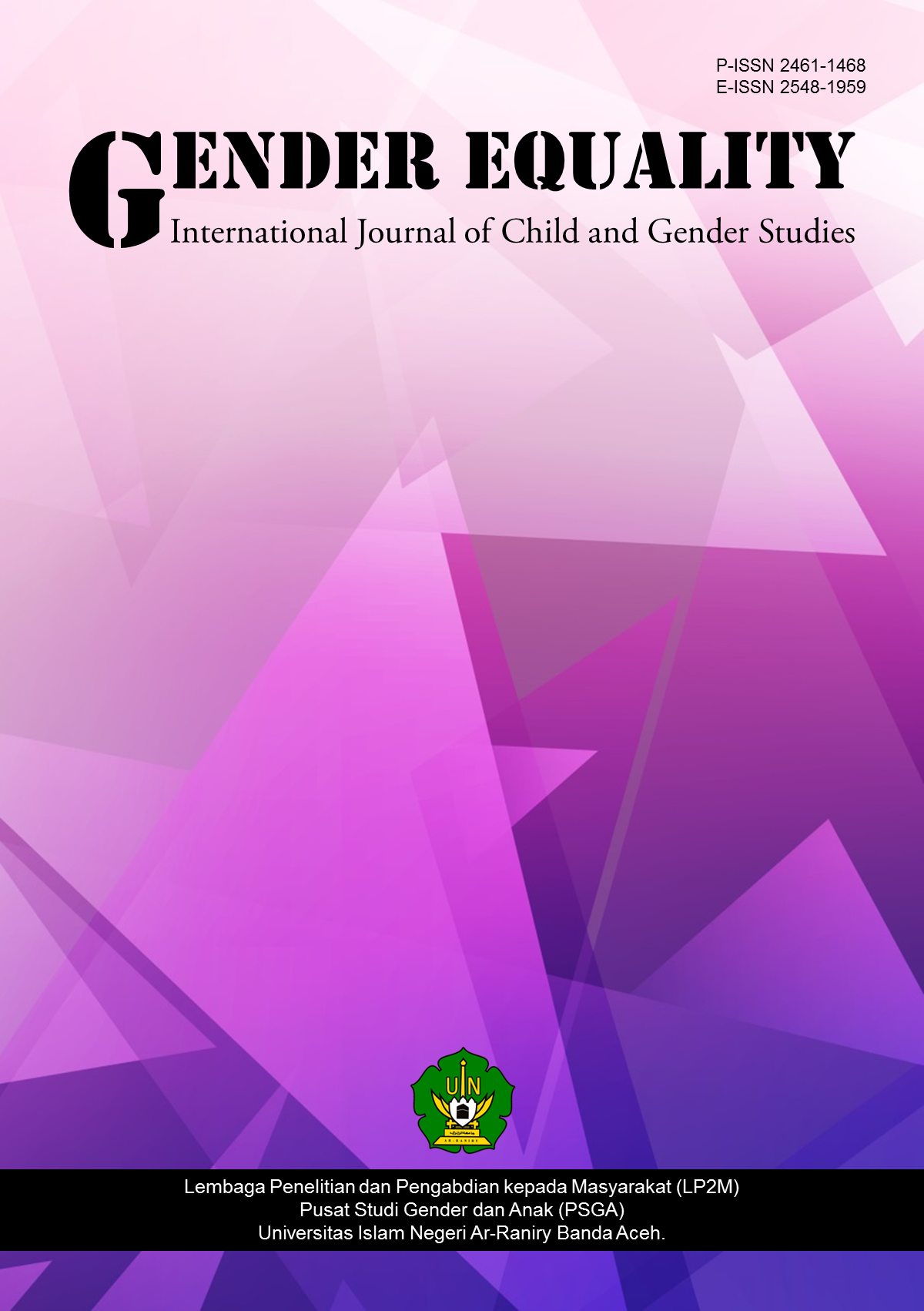Sexual harassment among disabilities in Makassar City: An Islamic law perspective
DOI:
https://doi.org/10.22373/equality.v10i2.25849Keywords:
Sexual Harassment, Women, People with Disabilities, Islamic LawAbstract
The main objective of the research is to find out the risk of sexual harassment of persons with disabilities in Makassar City from the perspective of Islamic Law. This type of research is qualitative research (field research), with the research approach being theological-normative, sociological, and juridical. Primary data sources were eight subjects. The subjects were five women with disabilities, a psychologist, two social workers, and a religious figure. The secondary data is obtained through books, journal articles, government data, laws, fatwas, and research reports by utilizing libraries, online databases, and websites of related institutions. The data collection methods used are observation, interviews, documentation, and reference searches. Data processing and analysis techniques are carried out in three stages: data reduction, presentation/display, and conclusion drawing. The results of this study show, from an Islamic law perspective, that the protection of women with disabilities is supported by principles such as human dignity (al-Karāmah al-Insāniyah), equality (al-Musawah), justice (al-'Adalah), and freedom (al-Hurriyah). Islam underscores the importance of safeguarding and respecting the rights of all individuals, including those with disabilities. Islamic sanctions for sexual harassment can range from ta'zir (discretionary punishments) to had (prescribed punishments), depending on the severity of the offense. These Islamic principles align with human rights standards and provide a foundation for fostering a more equitable and secure environment for women with disabilities. The research implications include the development of an Islamic law-based protection system, raising social awareness, and establishing a support network to create a safe environment for women with disabilities.
References
Al-Jaziri, Abd al-Rahman bin Muhammad Awad. (2003). Kitābu al-fiqh ‘ala mażahib al-arba’ah, Juz 5 (Cet.II; Lebanon: Dar al-Kutub al-Ilmiyah.
Al-Shiddieqy, Tengku Muhammad Hasbi. (1966). Syari’at Islam Menjawab Tantangan Zaman. Cet. II; Jakarta: Bulan Bintang.
Al-Tirmiżi, Abu ‘Isā Muhammad bin ‘Isa. (1996). Al-jāmi’ al-kabir Sunan al-Tirmiżi. Jilid 3. Cet.I; Beirut: Dar al-Garbi al-Islamiy.
Badan Pusat Statistik. (2023). Statistik kriminal. Badan pusat statistik, 021, 1–62. https://www.bps.go.id/id/publication/2023/12/12/5edba2b0fe5429a0f232c736/statistik-kriminal-2023.html.
Fadhilah, N. (2020). Kecenderungan perilaku seksual beresiko di kalangan mahasiswa: kajian atas sexual attitude dan gender attitude. Marwah: Jurnal Perempuan, Agama Dan Jender, 19(2), 171. https://doi.org/10.24014/marwah.v19i2.9746.
Fadhilah, N. & R. (2023). Problematic preventive efforts ff sexual harassment through islamic gender justice values-based education. Gender Equality: International Journal of Child and Gender Studies, 9(2), 220–234. https://doi.org/http://dx.doi.org/10.22373/equality.v9i2.19586.
Habrat, D. (2023). State of helplessness of a victim in the context of sexual abuse of a person with disabilities. Studia Prawnoustrojowe, 62, 43–55. https://doi.org/10.31648/sp.9436.
Joko Sampurno, R. D. (2024). The myth of equality: Sexual harassment behind a woman’s desk. Gender Equality: International Journal of Child and Gender Studies, 10(1), 80. https://doi.org/10.22373/equality.v10i1.22302
Majelis Ulama Indonesia, Fatwa MUI Nomor 57 Tahun 2014.
Muslich, Ahmad Wardi. (2005). Hukum pidana Islam. Jakarta: Sinar Grafika.
Pristiandau, D. L. (2024). Perempuan penyandang disabilitas rentan jadi penyintas kekerasan. Kompas.Com. https://lestari.kompas.com/read/2024/03/19/140000886/perempuan-penyandang-disabilitas-rentan-jadi-penyintas-kekerasan
Republik Indonesia, Undang-Undang RI Nomor 12 Tahun 2022, Pasal 5-6.
Rohim, A. (2023). Stigma dan diskriminasi dalam dunia pendidikan untuk disabilitas: disabilitas dan pendidikan di Indonesia. In Tahta Media Group. Tahta Media Group.
Syamsuri. (2019). Pesantren dan fiqih disabilitas: studi atas pemahaman santri pondok pesantren di Probolinggo Jawa Timur. At-Turas: Jurnal Studi Keislaman, 6(2), 272–305.
Syarbaini, A. (2018). “Teorita’zῑrdalam hukum pidana Islam.” Jurnal Ius Civile : Refleksi Penegakan Hukum Dan Keadilan, no. 2, 9–10.
Tangri, S. S., Burt, M. R., & Johnson, L. B. (1982). Sexual harassment at work: Three explanatory models. Journal of Social Issues, 38(4), 33–54. https://doi.org/10.1111/j.1540-4560.1982.tb01909.x
United Nations Entity for Gender Equality and the Empowerment of Women. (2018). Towards An End To Sexual Harassment : The Urgency And Nature Of Change In The Era Of # Metoo. UN Women.
United Nations Entity for Gender Equality and the Empowerment of Women. (2020). Sexual harassment against women with disabilities in the. UN Women.
Widinarsih, D. (2019). Penyandang disabilitas di indonesia: perkembangan istilah dan definisi. Jilid Ilmu Kesejahteraan Sosial, 20, 127–142.
Zareei Mahmoodabadi, H., & Akrami, L. (2021). Sexual abuse in adolescent girls and boys with mild intellectually disable. Journal of Community Health Research, 10(2), 128–135. https://doi.org/10.18502/jchr.v10i2.6589
Downloads
Published
Issue
Section
License
GENDER EQUALITY: International Journal of Child and Gender Studies allows the author(s) to hold the copyright and to retain the publishing rights without restrictions. Authors who publish with this journal agree to the following terms:
- Authors retain copyright and grant the journal right of first publication with the work simultaneously licensed under a Creative Commons Attribution License that allows others to share the work with an acknowledgment of the work's authorship and initial publication in this journal.
- Authors are able to enter into separate, additional contractual arrangements for the non-exclusive distribution of the journal's published version of the work (e.g., post it to an institutional repository or publish it in a book), with an acknowledgment of its initial publication in this journal.
- Authors are permitted and encouraged to post their work online (e.g., in institutional repositories or on their website) prior to and during the submission process, as it can lead to productive exchanges, as well as earlier and greater citation of published work.



